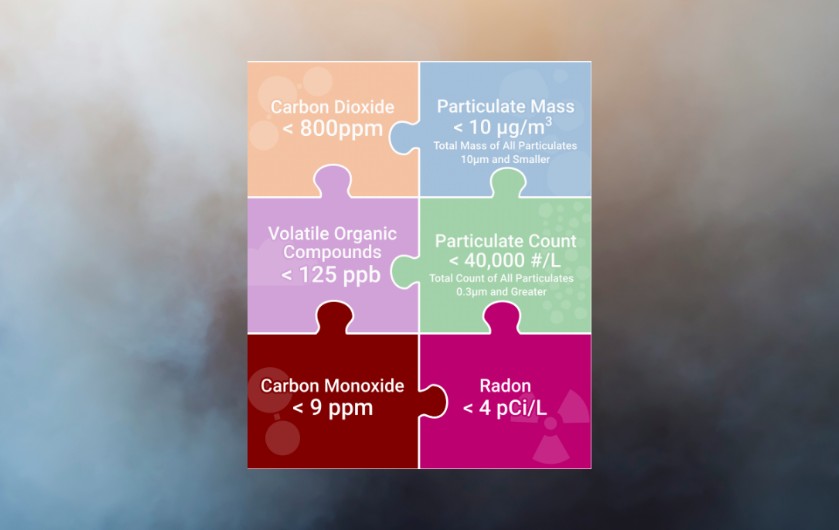Related Articles
newspaperHealthy Indoor Air Quality Standards: Carbon Dioxide (CO2)
newspaperHealthy Indoor Air Quality Standards: Volatile Organic Compounds (VOCs)
newspaperHealthy Indoor Air Quality Standards: Particulates (PC0.3 and PM10)
Build Equinox’s healthy Indoor Air Quality (IAQ) Standard’s carbon monoxide and radon pollutant guidelines are discussed this month. Our IAQ Standard for carbon dioxide (CO2), VOCs (Volatile Organic Compounds), PM10 (particulate mass density) and PC0.3 (particulate count density) are based on occupancy and occupant activities that generate those pollutants. Carbon monoxide (CO) and radon are different because they are not based on occupancy but rather by choice for CO, and construction methods and geology for radon.
CO and its associated pollutants (nitrogen oxide pollutants, NOx) in buildings are from indoor combustion processes and from fossil fuel powered transportation and industries. Radon is similarly not caused by occupancy but by building construction and geology. Indoor concentrations of these pollutants are impacted by a building’s ventilation and air filtration practices.
Build Equinox healthy Indoor Air Quality Standard (IAQS) for CO and radon are based on EPA guidance for carbon monoxide and radon:
• Carbon monoxide (CO) should be less than 9ppm (EPA Carbon Monoxide Risk and Assessment document) over an 8 hour period, with no more than one occurrence per year. We note that nitrogen oxide (NOx) pollutants are formed by indoor combustion and often at levels that exceed EPA guidance (100ppb NO2), causing irritation to building occupants with respiratory sensitivities.
• Radon should be maintained less than 4pCi/liter (EPA Radon information website)
Carbon Monoxide (CO)
Carbon monoxide is a combustion product of fossil fuels, and its build up indoors is due to combustion processes such as gas cooking and gas heaters layered on top of outdoor combustion sources such as today’s automotive combustion engines and fossil fueled industries. Transition of transportation to electric vehicles and non-fossil fuel alternatives for powering industry are reducing outdoor CO and NOx concentrations.
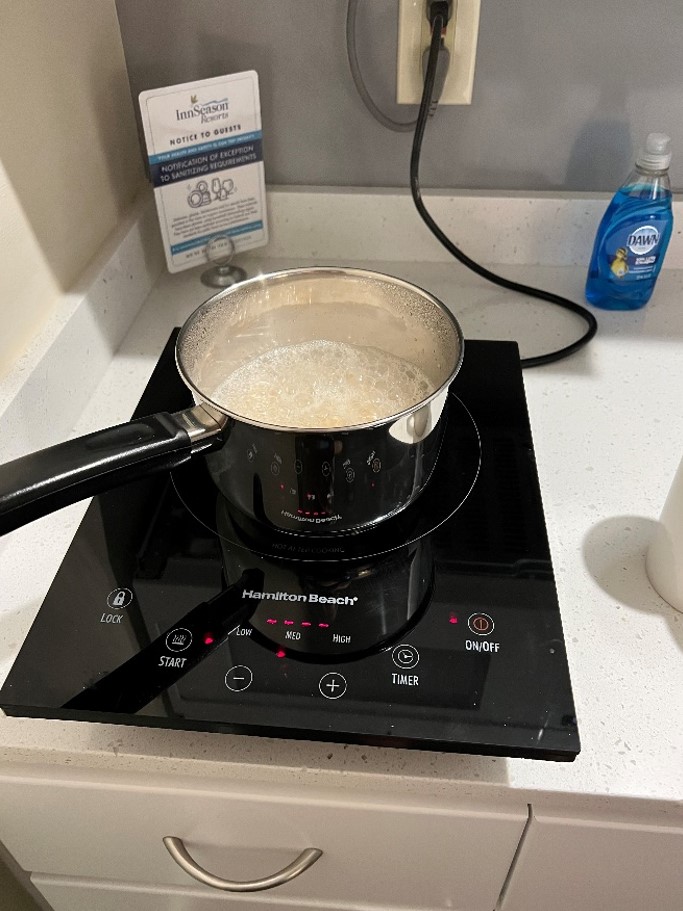
Converting to non-gas alternatives such as electric induction cooktops and electric ovens eliminates carbon monoxide. Nitrogen oxides (NOx), a pollutant formed from nitrogen and oxygen in air passing through high temperature combustion processes. NOx is a significant respiratory irritant that is reduced by switching to non-gas alternatives for cooking and heating. While many chefs hold dear gas cooking, as were cooks a century ago who reluctantly gave up wood burning stoves for gas and electric cooking, acquiring an inexpensive (<$100) induction cooktop is a simple way to try out an alternative cooking method (see Figure 1) that does not produce CO and NOx.
Regarding carbon monoxide:
• Carbon monoxide is odorless.
• Carbon monoxide is poisonous.
• Carbon monoxide causes brain damage.
• Carbon monoxide is from fossil fuel combustion.
• Carbon monoxide sends 50,000 people/year to Emergency Rooms in the US
• Carbon monoxide is the second leading cause of unintentional death by poisoning in the US (after alcohol poisoning, and just ahead of non-tobacco smoke inhalation fatalities).
The Centers for Disease Control and Prevention website contains practical information on carbon monoxide and poison prevention guidelines. A recent publication describes carbon monoxide poisoning in the US (Mortality and Morbidity of Unintentional Carbon Monoxide Poisoning: United States 2005-2018, Annals of Emergency Medicine, Vol 81, Issue 3, Mar 2023).
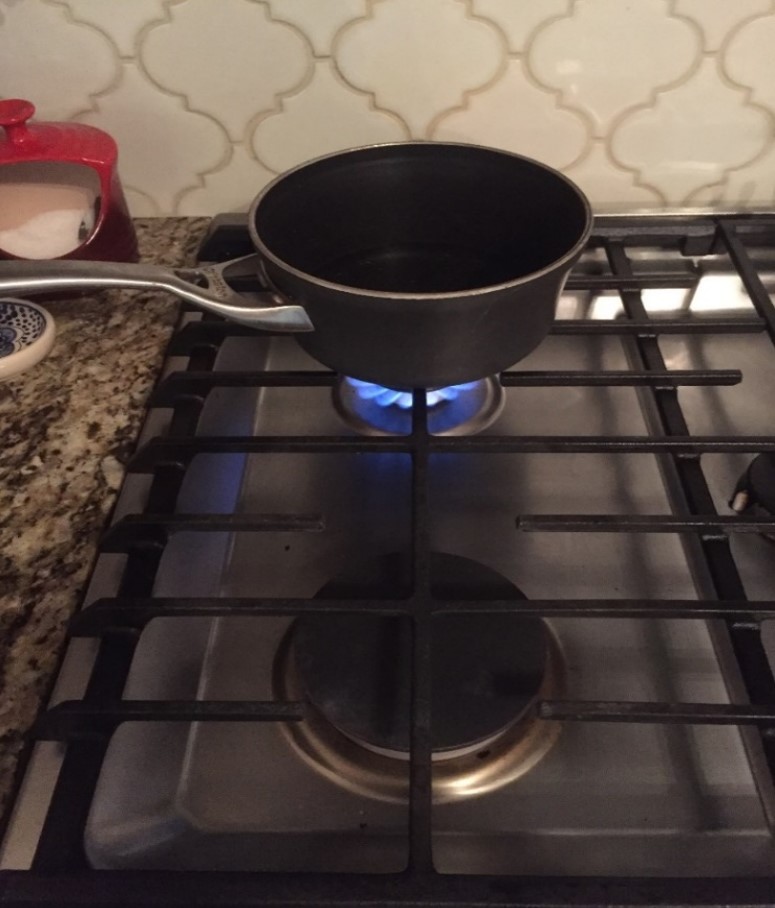
Combustion of fossil fuels ideally breaks hydrocarbon molecules into carbon dioxide and water. Nothing in the world is perfect, and combustion in the real world creates an array of pollutants with carbon monoxide and nitrogen oxides as two important pollutants. Carbon monoxide is formed when insufficient oxygen is available for complete combustion of a hydrocarbon molecule. Nitrogen oxides, which cause respiratory irritation, are created from nitrogen and oxygen in the air that combines at elevated temperatures.
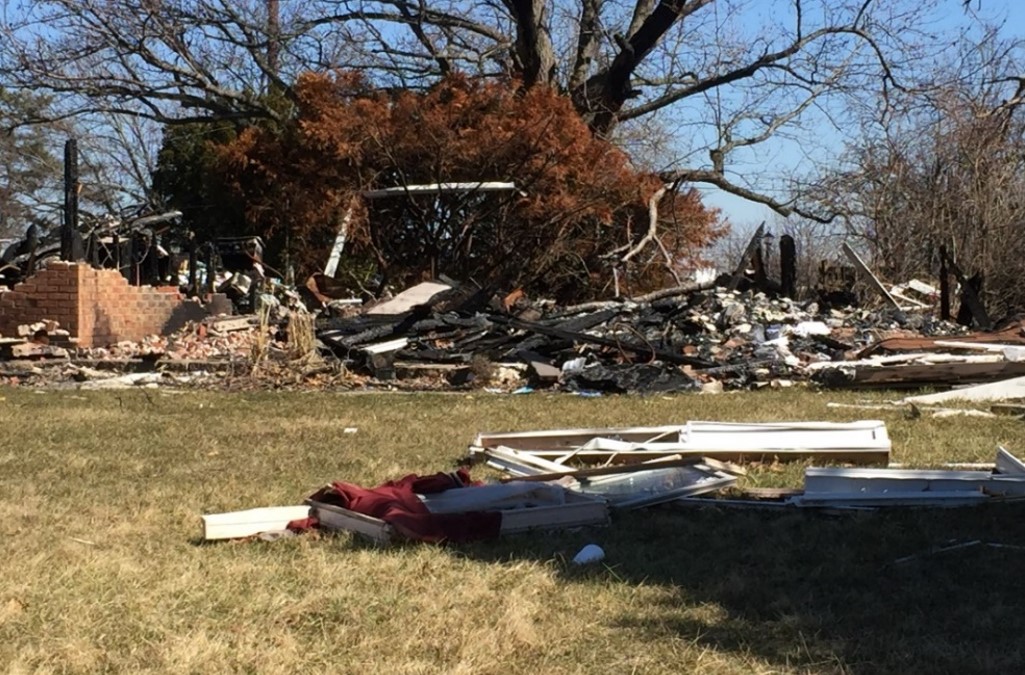
A study of unvented gas heaters by researchers at the University of Illinois found 20% of their sample (30 homes) exceeded EPA’s 9ppm CO limit. The authors noted that CO did not correlate strongly to carbon dioxide concentrations, the dominant combustion pollutant formed, concluding that various factors affect CO’s formation. The investigators also found that 80% of the test homes exceeded WHO (World Health Organization) guidelines of 110ppm of NO2, a primary constituent of the NOx family of pollutants. US EPA has set current NO2 guidelines at 100ppm.
Similar results have been found for cooking with natural gas by researchers at Lawrence Berkeley National Laboratory (LBNL). Elevated levels of CO and NOx depended on cooking time and use of cooking exhaust hoods. A California study of gas cooking pollution found that exhaust hoods are only used 35% of the time, leading to elevated CO and NOx pollutant concentrations.
Respiratory sensitivities (eg, asthma, allergies, COPD) affect nearly 10% of the general populace, resulting in 33% of homes having 1 or more household members impacted by indoor gas combustion pollutants.
Apart from health aspects in homes, gas adds an additional level of danger (Figure 3). The explosive nature of a relatively small amount of gas is an unfortunate and frequent occurrence in communities with neighborhood gas distribution. All forms of energy powering our homes, transportation and industries need to be respected. Eliminating the duplicate utility delivery gas to homes by replacing gas with today’s efficient and reliable heat pumps and induction cooking saves community money and reduces safety protection needs. Strong marketing and lobbying forces for gas industries will undoubtedly keep the debate active for some time.
Radon Control
Radon is the second leading cause of lung cancer after tobacco smoke. Unlike carbon monoxide that immediately kills its victims, radon takes a few decades to creep up on its victims. Our April 2022 article (Smart Ventilation and Filtration Impacts on Radon) provides background on the radon’s destructive path. As described in the article, radon’s emergence and detection in a home is only the beginning of its 22+ year journey of successive radioactive decays in our homes and bodies.
Per EPA’s current guidance, maintaining radon below 4pCi/liter reduces the probability of radon’s cancer forming potential. As with most other pollutants, it is important to realize that radon’s concentration, characterized by measuring radioactivity in the air, is a balance of how fast radon flows into a building and the amount of outside ventilation air flowing through the building. We should strive to reduce radon’s flow into a building to a level where the ventilation needed for keeping us healthy (ie, Build Equinox healthy IAQ Standard) is also sufficient to keep radon below its recommended limit.
Figure 3 shows trends in radon concentration (“pico-Curie per liter” or pCi/liter) as a function of the rate of radon flow into a home, generally from cracks, joints, drains, and sump pits in building basement and foundation areas in contact with ground. Ventilation air dilutes radon concentrations, however, minimizing flow of radon into a home is an important first step.
Reducing radon’s flow below 10pCi/sec makes a home less sensitive to variations in ventilation and infiltration air flow. For example, a 100pCi/sec flow of radon into the home may be below 4pCi/liter during windy days when infiltration and ventilation exceeds 60cfm. When ventilation and infiltration are below 60cfm, radon concentrations will exceed 4pCi/liter. Reducing radon inflow to 10pCi/liter significantly reduces the potential for radon to exceed 4pCi/liter.
Build Equinox’s healthy IAQ Standard more than doubles current building ventilation standards (ASHRAE 62.1 and 62.2), decreasing the potential for radon buildup. With CERV2 and CERV-1000 smart ventilation automatically managing ventilation and IAQ, ventilation levels needed for maintaining healthy IAQ also beneficially contributes to reducing radon. As noted in our article, maintaining a slightly positive pressure in a home, such as slightly increasing supply air fan flow relative to exhaust fan air flow in balanced ventilation systems provides an additional means to reduce radon flow into a home. Exhaust-only ventilation systems should be avoided. Sub-foundation radon mitigation systems that maintain negative pressure below a building’s foundation is an effective way to short circuit radon’s flow away from a building interior to the outdoor environment.
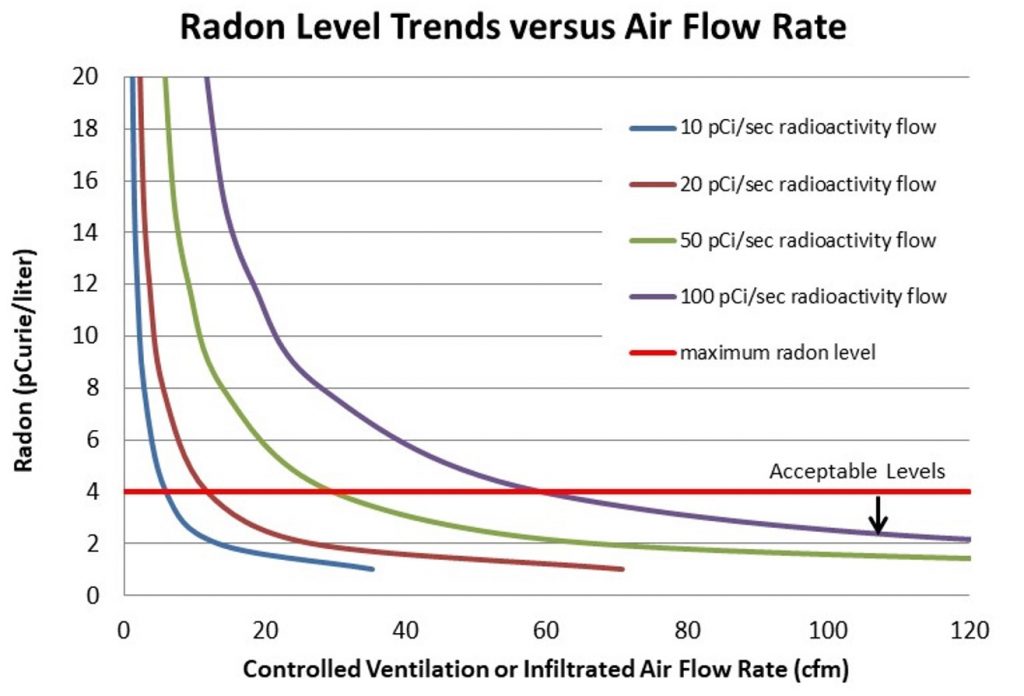
Summary
Build Equinox healthy IAQ Standard for CO and radon follow EPA’s recommended guidelines that are based on health risks assessments. CO is a pollutant cause by fossil fuel combustion and elimination of indoor gas combustion for cooking and heating reduces CO and associated respiratory pollutant irritants such as NOx. Removing utility gas supply to a home also reduces gas leakage hazards and eliminate gas customer service supply fees ($22/month in central Illinois). Radon impacts on a home occur due to geology and construction characteristics of a home. Mitigation of flow into a home is the important first step, especially in regions known to have high radon emission potential, followed by effective home ventilation practices, such as following BE healthy IAQ Standard.
Related Articles
newspaperHealthy Indoor Air Quality Standards: Carbon Dioxide (CO2)
newspaperHealthy Indoor Air Quality Standards: Volatile Organic Compounds (VOCs)
newspaperHealthy Indoor Air Quality Standards: Particulates (PC0.3 and PM10)





